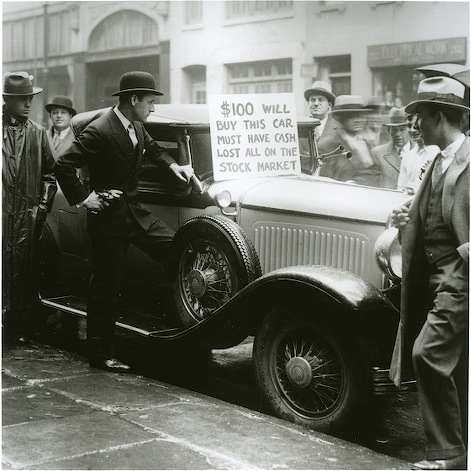The Crash of 1929 -- seems like old times
11/10/08 09:15 AM

By ED BARK
First shown in 2003 under PBS' American Experience banner, here's a classic cautionary tale that bears repeating, oh, at least every month or so.
The Crash of 1929 (8 p.m. central on KERA/Ch. 13 in D-FW) is a one-hour crash course in events leading to the United States' first stock market-fueled financial crisis.
The panic-fed meltdown of Oct. 29, 1929 laid waste to the wealth and life savings of stock-aholics ranging from Groucho Marx to "bull of the bulls" William Durant to that era's equivalents of Joe the Plumber. It seemed as if everybody had something to lose when the bubble finally burst.
"The (stock) market had entered popular culture," says narrator Philip Bosco. "Wall Street became Main Street. Everyone was talking stocks. Watching the ticker became a national sport."
Borrowing on credit with the certainty of getting rich quick was fun, easy and of course too good to be true. Not everyone bought into the stock market. But for the first time, everyday Americans were ready, willing and able to join America's storied Big Shots in wagering on stocks and then watching them pay off. Intoxicating.
The parallels to today are striking, even including bail-outs when the stock market took its first deep plunges. Famed economist John Kenneth Galbraith, who died in 2006, could afford to be a bit snooty in reminding the filmmakers that nothing ever changes when greed and easy money partner up.
"There's nothing unique about this," Galbraith says. "It is something which happens every 20 or 30 years because that is about the length of the financial memory. It's about the length of time that it requires for a new set of suckers, if you will, a new set of people capable of wonderful self-delusion to come in and imagine that they have a new and wonderful fix on the future."
Crash of 1929 also includes interviews with descendants of that era's multi-millionaires, beginning with the son and daughter of Charles E. Mitchell, president of National City Bank. They reminisce from within the splendorous home that was once the family's everyday palace.
"The bank, prior to father's being elected president in 1921, was geared mainly to doing business with large corporations," Craig Mitchell recalls. "Father pointed the bank, for the first time, in the direction of going after the little man and . . ."
"Don't call him the little man," sister Rita scolds. "It was Everyman."
"Going after" meant granting Everyman an interest-bearing loan in times when "amazing new products," ranging from underarm deodorants to pug-in refrigerators, were tempting the masses to spend now, pay later. It all passed the smell test during the hazy, crazy "dawn of the consumer revolution."
And now, here we go again. In that context, Crash of 1929 fittingly begins and ends with lyrics from "Blue Skies," the 1929 hit song that promised prosperity forevermore.
Rita and Craig Mitchell remember those days by singing/reciting a few bars in the film's opening minutes.
"People believed that everything was going to be great always -- always," she recalls. "There was a feeling of optimism in the air that you cannot even describe today."
Crash of 1929 plays itself off with another nod to "blue skies smiling at me. Nothing but blue skies do I see."
It still sounds jolly, all right. But it feels like a funeral dirge.
Grade: A
